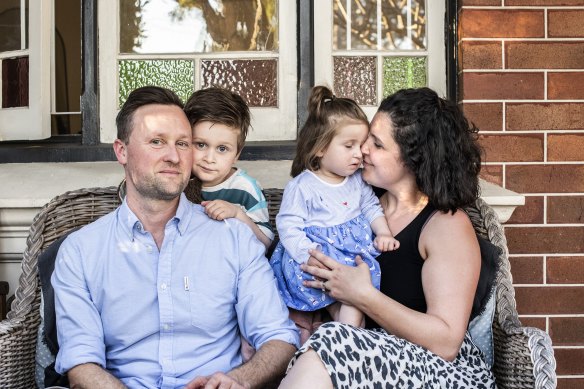Save articles for later
Add articles to your saved list and come back to them any time.
Mostly, Charlotte Colley is just like any other two-year-old. She goes to daycare, loves splashing about in the pool or at the beach, and has no problems letting her parents Brett Colley and Sarah Matthews know exactly what she wants.
“She is very vocal, for someone who’s nonverbal,” Colley said. “She makes you work for the smiles and the laughs, but she’s got a lot of sass, and she’s a brave little thing.”
Brett Colley and Sarah Matthews with their son Finn and daughter Charlotte.Credit: Steven Siewert
But Charlotte’s doctors and parents aren’t sure if she will ever be able to walk, talk or swallow food. In November, she was diagnosed with Cockayne syndrome, an extremely rare and inherited condition affecting the neurological development of children.
It is one of more than 150 rare genetic conditions Australian scientists have identified as causing dementia in children, in world-first research that hopes to boost scientific and public understanding of a condition most people don’t even know exists.
The study, published in the journal Brain, estimated that more than 100 babies born in Australia each year would develop childhood dementia, a similar number to those born with cystic fibrosis. The 91 Australians who died from the condition in 2021 are only slightly fewer than the number of children who died from cancer before the age of 15.
The conditions are all marked by a period of development before the often rapid onset of symptoms of premature ageing. Life expectancy is just nine years, and 70 per cent don’t live to see their 18th birthdays.
Lead author Dr Nick Smith from Adelaide University said some of the genetic abnormalities that cause dementia in adults can also cause dementia in children, such as the defect in one gene which causes both Gaucher’s disease in children and Parkinson’s in adults.
“The usual reaction you get is that this doesn’t happen to children, but quite the contrary; this is a condition that young people in our community are dealing with,” he said.
Megan Maack, who commissioned the research as chief executive and director of the Childhood Dementia Initiative, said grouping the conditions together for the first time would help researchers and policymakers understand the scale of the problem.
“Historically, the hundred-plus conditions that cause childhood dementia have been understood in isolation, and so the way we research, the way we care, the way we set policy, has been very fragmented,” she said. “While the genetic cause is different, the challenges families face are all common, so it makes sense to look at them all together.”
Maack, who has two children with childhood dementia caused by Sanfilippo syndrome, said most families received support through the NDIS, but had to fight to receive proper care for their children.
“Getting a diagnosis for one of these conditions is really difficult,” she said. “And once they’re diagnosed, there are no care pathways, no consistent models of care … palliative care services aren’t set up to care for kids with childhood dementia.”
Matthews, from Dulwich Hill in Sydney, said she was proud of the way Australia’s medical system had supported their daughter, but the past two years had been a constant search for answers involving dozens of medical specialists and few explanations.
“I’m a lawyer for a living, but I feel like I’ve never had to advocate as I have had to do, to get Charlotte to stand out and to say this isn’t something that she’s going to grow out of,” Matthews said.
“If there’s going to be gene therapies, and we’re hopeful that there will be, then early diagnosis and early treatment will be absolutely critical.”
The Morning Edition newsletter is our guide to the day’s most important and interesting stories, analysis and insights. Sign up here.
Most Viewed in National
From our partners
Source: Read Full Article


